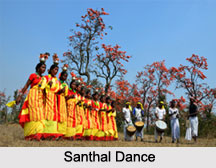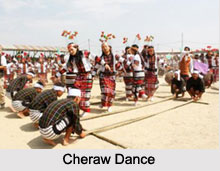 Tribal Dances of East India are very colourful. The tribal dances of Eastern India are directly connected to the soil. The very much native performing arts are firmly performed by popularly known as "Adivasis". The original dance performance is in custom since the primeval times of the developing civilizations.
Tribal Dances of East India are very colourful. The tribal dances of Eastern India are directly connected to the soil. The very much native performing arts are firmly performed by popularly known as "Adivasis". The original dance performance is in custom since the primeval times of the developing civilizations.
Some of the popular Tribal Dances of East India are as follows:
Santhal Dance: The Santhal tribes in Jharkhand perform the popular Santhali Dance. This is a typical group dance performed on special occasions. A very popular dance of Jharkhand, this dance form has attained popularity all across India and also has been featured in many reputed Bengali films like `Agantuk` by Satyajit Ray. Santhali Dance is primarily performed on special occasions, especially during spring festival, accompanied by a traditional song. This dance not only projects the culture or traditions of the local tribes but also showcases the strength of unity. Flutes, drums, pipes and cymbals are among the musical instruments used in course of the performance of Santhali Dance. Santhal Dance is very similar to the bamboo folk dance of Assam and Mizoram. The male dancers wear Dhoti and turban, and decorate their bodies with branches of trees, leaves and flowers. Since the Santhals are believed to be close to nature, they use natural decors such as leaves, branches and flowers to do their make-up and design their clothes. The women dancers usually wear white or yellow sarees with red borders and adorn their hair with wild flowers. The length of the saree is about three inches above the heel. The colourful costumes worn by the tribal people happen to be the main attraction of the Santhali dance in Jharkhand. 
Cheraw Dance: Cheraw is one of the most popular tribal dance forms popular in Mizoram. The dance looks natural and rhythmic but it needs brilliant practice to perform. Two men sitting face to face, open and close two extended bamboos by sitting on the ground. They do it with the beats and the girls skilfully adorned in popular Mizo dance attires called Puanchei, Kawrchei, Vakiria, and Thihna jump in and out with the beat of the tune as well. Generally, drums and gongs are played to create the music for Cheraw show.
Garia Dance: Garia Dance is performed during the shifting cultivation. The tribal dance of Tripura is performed to devote and thank God Garia in the month of April after a satisfying harvesting. This is a seven-day festival called as Garia Puja, allures onlookers with attractive dances, music, and frolic.
Dhimsa Dance: Dhimsa Dance is among the Indian tribal dances. It is a dance form of the tribes in the eastern part of Andhra Pradesh, such as Araku Valley near Vizag. The dance is also practised in the tribal regions of Odisha and Madhya Pradesh. The dance is performed during festivals, weddings and also at the time of the "hunting festival" in April when men and women dance for hours. Furthermore, various critics trace the origin of Dhimsa to the Koraput area of Orissa. The dance is simple and encompasses unique rhythm. Dhimsa Dance presents an enthralling sight as because of the earthy colours of the tribal wear. The costume of the dancer focuses on the movement of the dancers without much emphasis on expression or a literary text. The attire is colourful; shades of red, yellow and green are worn and are called girijans attire themselves. The movements of the dance form are quite expressive. The feet and the hands by the group dominate the dance. An elemental rhythm and animated, quick steps with manoeuvres are the distinctive features of the dance form.



















